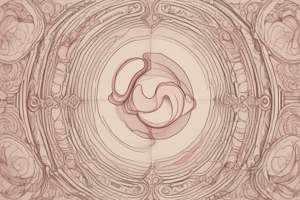Podcast
Questions and Answers
What are the main clinical features of uterine inversion?
What are the main clinical features of uterine inversion?
The main features are shock out of proportion to blood loss, bradycardia due to increased vagal tone, and a mass palpable in the vagina.
What initial steps should be taken to manage a patient with uterine inversion?
What initial steps should be taken to manage a patient with uterine inversion?
Initial steps include maintaining the airway, providing 100% O₂, inserting wide bore i.v. cannulae, and administering warmed crystalloid i.v. rapidly.
Describe the technique for hydrostatic replacement in cases of uterine inversion.
Describe the technique for hydrostatic replacement in cases of uterine inversion.
Hydrostatic replacement involves using 2-5 L of warmed normal saline via a ventouse cup, allowing the fluid to infuse under gravity while maintaining a seal at the introitus.
What should be done if manual replacement of the uterus is unsuccessful?
What should be done if manual replacement of the uterus is unsuccessful?
How should the uterine cavity be managed post-reduction following uterine inversion?
How should the uterine cavity be managed post-reduction following uterine inversion?
What cardiovascular feature is commonly observed in cases of uterine inversion?
What cardiovascular feature is commonly observed in cases of uterine inversion?
In cases of incomplete uterine inversion, what might be felt upon examination?
In cases of incomplete uterine inversion, what might be felt upon examination?
What is an immediate action to take if the heart rate is less than 60/min during uterine inversion?
What is an immediate action to take if the heart rate is less than 60/min during uterine inversion?
How should crystalloid fluids be administered during the management of uterine inversion?
How should crystalloid fluids be administered during the management of uterine inversion?
What should be done if manual replacement of the uterus fails?
What should be done if manual replacement of the uterus fails?
Flashcards are hidden until you start studying
Study Notes
Uterine Inversion
- A serious obstetric emergency presenting with shock and haemorrhage
- Shock is often out of proportion to blood loss
- Bradycardia due to increased vagal tone
- Vaginal examination reveals a mass in the vagina
- Normally palpable postpartum uterus cannot be felt above the symphysis
Incomplete Inversion
- May present more subtly
- Continuing postpartum haemorrhage (PPH) despite a contracted uterus
- Fundus of the uterus may feel dimpled
Pathway of Care
- Airway: Maintain as level of consciousness requires
- Breathing: Give 100% O₂ by face mask or bag and mask, if needed
- Circulation: Shock. Usually severe
- Insert wide bore i.v. cannulae x 2 (14G)
- Send blood for FBC, 4 units x match, clotting
- Give warmed crystalloid i.v. as rapidly as possible
- Atropine 300-600 µg i.v. if heart rate <60/min
- Establish monitoring of pulse, BP, urine output (via catheter)
- Establish adequate analgesia and call for senior help if available
- If Syntocinon is running stop it
Manual Replacement
- Attempt as soon as possible
- Gently push the fundus back through the cervix
- If the placenta is still attached leave it
Hydrostatic Replacement
- If manual replacement unsuccessful
- Get 2-5 L warmed normal saline
- Attach giving set onto a silastic ventouse cup
- Prime the system
- Place the ventouse in the vagina
- Run in the fluid under gravity from a height of 2 m maintaining a seal manually at the introitus
- Reduction is usually achieved in approximately 10 mins
Laparotomy
- Required if hydrostatic replacement fails
- Failure rate <3%
Post-Reduction Management
- Maintain hand in the uterine cavity until a firm contraction occurs
- Continue i.v. oxytocin
- Remove the placenta and explore the cavity gently for trauma
Uterine Inversion
- Presents with shock and haemorrhage often out of proportion to blood loss
- Bradycardia occurs due to increased vagal tone
- Urgent vaginal examination will reveal a mass in the vagina
- The post-partum uterus cannot be felt above the symphysis
Incomplete Inversion
- Presents with continued postpartum haemorrhage despite a contracted uterus
- May feel a dimpled fundus
Management
- Maintain airway, breathing, and circulation
- Insert two large bore IV cannulae (14G)
- Monitor pulse, blood pressure, and urine output
- Give warmed crystalloid IV fluids rapidly
- Give atropine if heart rate is less than 60 bpm
- Stop Syntocinon if running
- Attempt manual replacement of the uterus as soon as possible by gently pushing the fundus back through the cervix
- If placenta is still attached, leave it in place
- If manual replacement fails, attempt hydrostatic replacement
- Hydrostatic replacement is achieved with 2-5 L of warmed NS using a silastic ventouse cup in the vagina
- Run the fluid under gravity from a height of 2 m and maintain a seal manually at the introitus
- If hydrostatic replacement fails, laparotomy may be required
- Once the uterus is reduced, maintain a hand in the uterine cavity until a firm contraction occurs and IV oxytocin is given
- After firm contraction occurs, remove the placenta and gently explore the cavity for trauma
Studying That Suits You
Use AI to generate personalized quizzes and flashcards to suit your learning preferences.




